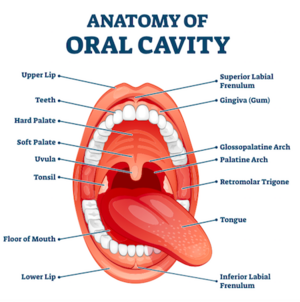Tongue: Difference between revisions
(Content added) |
(Content and Reference added.) |
||
| Line 9: | Line 9: | ||
</div> | </div> | ||
== Description == | == Description == | ||
The tongue is a muscular organ, which is situated in a hollow cavity of mouth. As seen in the diagram it has various structure | The tongue is a oval shaped, Pink ,Moist ,Solid Conical, muscular organ, which is situated in a hollow cavity of mouth. As seen in the diagram it has various structure around and several attachments. It moves freely from the anterior side which not directly attached to any other structure. Posterior part of the tongue is attached to numerous structures thus why Tongue plays several important roles such as facilitation of gustatory stimuli, facilitates mastication, speech pathway, as it helps with articulation.<ref>Dotiwala AK, Samra NS. Anatomy, Head and Neck, Tongue. [Updated 2021 Apr 19]. In: StatPearls [Internet]. Treasure Island (FL): StatPearls Publishing; 2021 Jan-. Available from: <nowiki>https://www.ncbi.nlm.nih.gov/books/NBK507782/</nowiki></ref><ref name=":0">Tongue [Internet]. Kenhub. 2022 [cited 7 January 2022]. Available from: <nowiki>https://www.kenhub.com/en/library/anatomy/tongue</nowiki></ref> | ||
[[File:Oral Cavity and Tongue.png|left|thumb]] | [[File:Oral Cavity and Tongue.png|left|thumb]] | ||
| Line 20: | Line 21: | ||
=== Anatomical Relationships === | === Anatomical Relationships === | ||
=== | |||
''Anterior and lateral -'' teeth | |||
''Superior -'' hard and soft palates | |||
''Inferior -'' mucosa of the floor of the oral cavity, sublingual salivary glands, posterior wall of oropharynx | |||
''Posterior -'' epiglottis, pharyngeal inlet | |||
''Lateral -'' palatoglossal and palatopharyngeal arches<ref name=":0" /> | |||
The mylohyoid muscle, which is responsible for raising the body of the tongue in high vowels and velar consonants. The hyoglossus, which pulls it downwards (and slightly backwards). The styloglossus, which pulls the tongue upwards and backwards. The genioglossus, which forms the bulk of the inferior part of the tongue and pulls the body of the tongue forwards. | |||
=== Function <ref>The tongue: structure and function relevant to disease and oral health. ''SADJ''. 2003;58(9):375-383.</ref><ref>AlJulaih G, Lasrado S. Anatomy, Head and Neck, Tongue Taste Buds [Internet]. Ncbi.nlm.nih.gov. 2022 [cited 7 January 2022]. Available from: <nowiki>https://www.ncbi.nlm.nih.gov/books/NBK539696/</nowiki></ref> === | |||
<ref>FUCCI D, PETROSINO L. The Human Tongue: Normal Structure and Function and Associated Pathologies. Speech and Language. 1981;:305-374.</ref> | |||
=== Nerve === | === Nerve === | ||
Revision as of 05:38, 7 January 2022
This article is currently under review and may not be up to date. Please come back soon to see the finished work! (7/01/2022)
Original Editor - User Name
Top Contributors - Shreya Trivedi and Oyemi Sillo
Description[edit | edit source]
The tongue is a oval shaped, Pink ,Moist ,Solid Conical, muscular organ, which is situated in a hollow cavity of mouth. As seen in the diagram it has various structure around and several attachments. It moves freely from the anterior side which not directly attached to any other structure. Posterior part of the tongue is attached to numerous structures thus why Tongue plays several important roles such as facilitation of gustatory stimuli, facilitates mastication, speech pathway, as it helps with articulation.[1][2]
Anatomical Relationships[edit | edit source]
Anterior and lateral - teeth
Superior - hard and soft palates
Inferior - mucosa of the floor of the oral cavity, sublingual salivary glands, posterior wall of oropharynx
Posterior - epiglottis, pharyngeal inlet
Lateral - palatoglossal and palatopharyngeal arches[2]
The mylohyoid muscle, which is responsible for raising the body of the tongue in high vowels and velar consonants. The hyoglossus, which pulls it downwards (and slightly backwards). The styloglossus, which pulls the tongue upwards and backwards. The genioglossus, which forms the bulk of the inferior part of the tongue and pulls the body of the tongue forwards.
Function [3][4][edit | edit source]
Nerve[edit | edit source]
Artery[edit | edit source]
Function[edit | edit source]
Clinical relevance[edit | edit source]
Assessment[edit | edit source]
Treatment[edit | edit source]
Resources[edit | edit source]
- ↑ Dotiwala AK, Samra NS. Anatomy, Head and Neck, Tongue. [Updated 2021 Apr 19]. In: StatPearls [Internet]. Treasure Island (FL): StatPearls Publishing; 2021 Jan-. Available from: https://www.ncbi.nlm.nih.gov/books/NBK507782/
- ↑ 2.0 2.1 Tongue [Internet]. Kenhub. 2022 [cited 7 January 2022]. Available from: https://www.kenhub.com/en/library/anatomy/tongue
- ↑ The tongue: structure and function relevant to disease and oral health. SADJ. 2003;58(9):375-383.
- ↑ AlJulaih G, Lasrado S. Anatomy, Head and Neck, Tongue Taste Buds [Internet]. Ncbi.nlm.nih.gov. 2022 [cited 7 January 2022]. Available from: https://www.ncbi.nlm.nih.gov/books/NBK539696/
- ↑ FUCCI D, PETROSINO L. The Human Tongue: Normal Structure and Function and Associated Pathologies. Speech and Language. 1981;:305-374.
Toungue Anatomy, structure and Physiology







